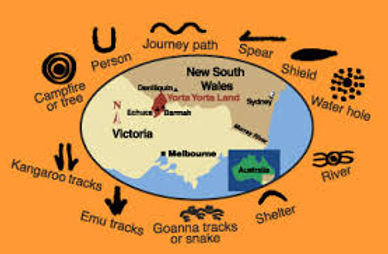
ABORIGINAL SPIRITUALITY
Beliefs:
“Aboriginal spirituality is so incredibly diverse”, meaning there is not one Aboriginally Spirituality, but many. However, the centre of all Aboriginal religions and life is Dreaming. ‘Dreaming’ cannot be expressed in the English language. Mudrooroo, an Aboriginal writer said ‘Our spirituality is a oneness and an interconnectedness with all that lives and breathes, even with all that does not live or breathe.’
They have a deep connection with the land. They have an obligation to look after their land, which has been law that has been passed down for many years. They best way to describe Indigenous peoples spiritual connection to their land is found in a publication of the ATSIC, ‘We don't own the land, the land owns us. The land is my mother, my mother is the land. Land is the starting point to where it all began. It's like picking up a piece of dirt and saying this is where I started and this is where I'll go. The land is our food, our culture, our spirit and identity.’
‘Aboriginal spirituality is the belief that all objects are living and share the same soul or spirit that Aboriginals share’, this is said by Eddie Kneebone, an Aboriginal Reconciliation campaigner and painter.
This means that the Aboriginal person’s soul or spirit is believed to “continue on after our physical form has passed through death”.
After the death of an Aboriginal person their spirit returns to the Dreamtime from where it will return through birth as a human, an animal, a plant or a rock. The shape is not important because each form shares the same soul or spirit from the Dreamtime. After their death, their spirit returns to the Dreamtime from where it will return through birth as a human, an animal, a plant or a rock. However, the shape has no relevance as each form shares the same soul or spirit from the Dreamtime.
Myths & Other Stories:
Bill Neidjie , a Kakadu elder, said, ‘Our story is in the land ... it is written in those sacred places ... My children will look after those places, That's the law.’ The term myth is used to describe the sacred stories that explain the origins of the land, the people, and their way of life. Myths explain profound religious truths about the important questions of life about how the world came into being, how people came into existence and relate to their land. All these myths come form he ancestral spirit beings of the Dreaming. A great number of these spirits are in animal or other form, which gives a greater rise to totemic connections with the human beings who descend from them. These myths and stories are told in pictures or they are sung and danced, acted out in rituals.
Sacred Texts:
Aboriginal spirituality do not have specific sacred texts, as they pass on their stories and teachings verbally. Their sacred stories are found on cave walls, ceremonial boards, ritual stones or rock walls. All of these sacred drawings are believed to have been made by their ancestors. Aboriginals believe these drawings hold power and authority.
Religious Rituals:
Rituals give structure and meaning to Aboriginal lives. Rituals consist of a basic pattern: preparation of the ritual place, making or refurbishing the ritual objects, and the preparation of the participants. Rituals are performed in a few days or hours. It consists of a series of songs and dances. An important part of rituals is that bodies must be painted in designs that link them to their spirit ancestors. There are many types of rituals including, birth rituals, male initiation, female initiation, death rituals and increase rituals.
Symbols:
Each tribe uses different symbols to represent something that holds a deep meaning. Dream time animals represent individuals in the Illawarra Aboriginal tribe, which strengthens totemic associations. Aboriginal Spirituality is said to be Totemic, which are natural objects, plants or animals that are inherited by members of a clan or family as their spiritual emblem. Totems define peoples' roles and responsibilities, and their relationships with each other and creation. Descendants of dream time heroes. Totems deepen their sense of connection to the land, as the land is vitally important to their
religion.
Social Structure:
The Aboriginal social structure consists of the elders being the highest, as they are seen to be the wisest, everyone else is below them. The elders fall into to categories, male and female. Male elders deal with concerns related to ales, while women elders deal with concerns related to women. Elders have many duties such as; initiating people into aspects of religion and spirituality, playing a role in resolving disputes about sacred objects. Female Aboriginals are responsibly for educating the young. Education is a consequential experience as they young will one day represent the future of the Dreaming.
Ethical Principles:
Aboriginals are bounded by the morals and regulations for their land and community. Laws in the Aboriginal Religion are based on the relationships with one's family, one's community, the lands and its creatures and on maintaining a balance with all of life. An
example of an ethical principle is as guardians of the country, individuals and groups are responsible for the protection of their country. This includes the insurance of animal life, plant life, sacred sites and passing this knowledge onto future generations.
Religious Experience & Spirituality:
Although Aboriginals to no expect their ancestors or other spiritual beings to reveal themselves directly or in an immediate way, through activities in some rituals, the ancestor beings are experienced in the person. They can usually feel ancestor powers through stories, rituals and sacred places.

